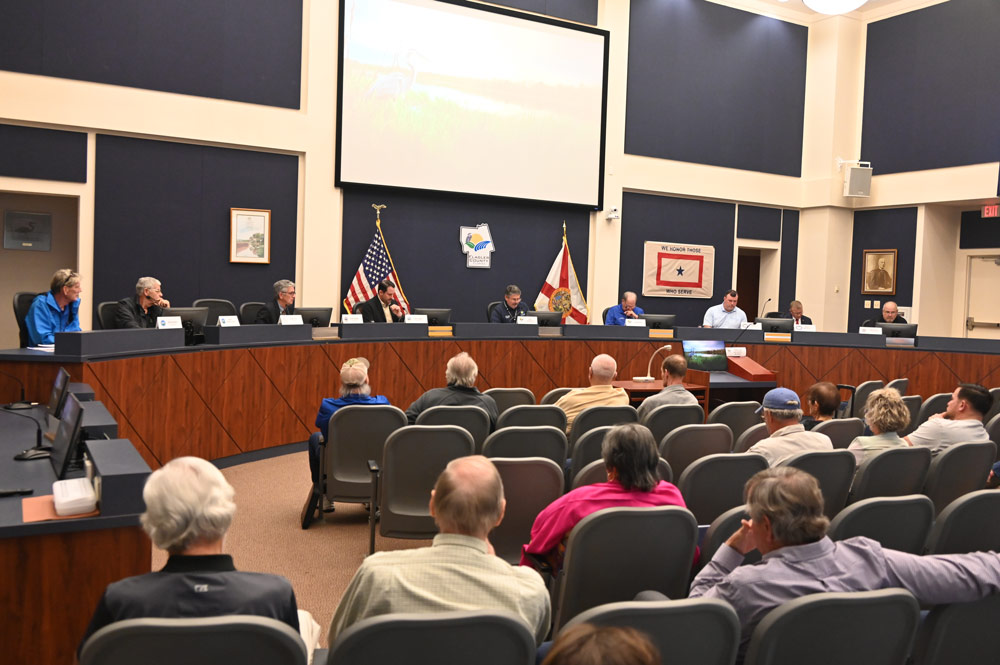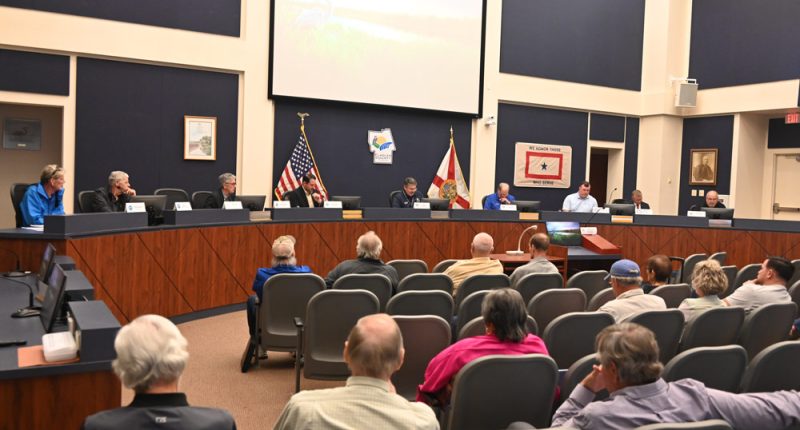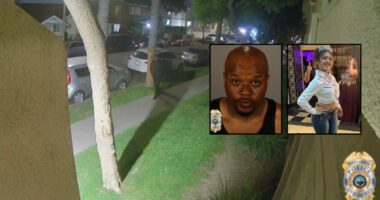
In Sum: In contrast with their joint meeting in February, representatives from Palm Coast, Beverly Beach, Bunnell, Flagler Beach, Marineland and the county were all more supportive of a proposed beach-management plan centered on raising the sales tax as they discussed it in their latest joint session Wednesday evening. Palm Coast remains the crucial hold-out for now, if not an immovable one. But time is running out.
![]()
Almost an hour into last night’s joint meeting of local governments to discuss an ambitious but contentious county plan to rebuild and protect Flagler County’s beaches, a resident from Beverly Beach called Ellen addressed the elected official from the floor, after her own town government had dubiously denied her the right at a recent workshop.
Ellen made a simple point the more-than one-third of Flagler County residents who are over 55 like her can relate to: when it comes to taxes, “some receive more benefit. Some receive less, but we’re all obligated to pay an equal amount,” she said. She gave familiar examples. She pays taxes for schools even though she has no children in school. She pays taxes for police protection even though crime is nearly non-existent in Beverly Beach. She doesn’t play pickleball and Kindle is her library, but she pays taxes that fund libraries and rec centers. Plus she’s a snowbird. She’s not here six months of the year.
“As you can see from these examples, in my opinion, it would be ridiculous to think that we can figure out a solution to the beach renourishment by trying to be fair,” Ellen said. “Instead, we need to–hate to use this term–we need to grow some balls, and we need to accept the fact that it needs to be done. We all need to step up and do our part.” Her tax prescription was a bit more Scandinavian than even the county is proposing, but she’d made her point.
By then the government representatives from Palm Coast, Beverly Beach, Bunnell, Flagler Beach, Marineland and the county had all spoken their piece on the plan, all of them this time in less abrasive, more accepting and pragmatic terms. Even Palm Coast and Beverly Beach. When this panel met in February to first discuss a much vaguer plan, Palm Coast and Beverly Beach sounded like Savonarolas condemning an abominable vice. This time they sounded more like Rockefeller Republicans rediscovering their inner pragmatist.
“I think I have receptive partners that are willing to continue to work and listen,” County Commission Chair Dance, who also chaired Wednesday’s meeting, said at its tail end.
The plan, crafted by County Administrator Heidi Petito and Deputy Administrator Jorge Salinas, depends on raising the sales tax by half a percent, granting Palm Coast and Bunnell half their share of that revenue (for Palm Coast, that’s $2.7 million in new revenue in the first year) in exchange for their support, but taking the full revenue from barrier island towns, plus the county’s full share, to direct it to beach management. Barrier island property owners would also pay a $160 annual fee per parcel. That figure is not set in stone, and the county is working on a grant program for those who can’t afford that much. The county would also appropriate a fraction of property tax revenue to the effort, plus a chunk of revenue from the tourist tax, which is paid overwhelmingly by visitors. That’s the plan in the main. It would put the county in charge of all 18 miles of beaches, both to rebuild them, maintain them, and prepare for future renourishments, which will be needed every six years.
The official line in Palm Coast is that its council still wants the sales tax portion put out for referendum. But County Commission Chair Andy Dance wanted to make this clear: the county is not asking the cities, including Palm Coast, to vote for a sales tax increase. Only the county would vote for that increase. “The county commissioners are taking the political hit,” he said. The county is asking the cities only to support the funding formula–the split of the revenue. A referendum would enable the money to be bonded. “But this is a pay-as-you-go plan,” Dance said, making the referendum unnecessary. (He did not say that the referendum would likely fail, if held.) “If we implement this plan this year, we start building those monies to be able to construct the next phase and then turn around and pay for their renourishments,” Dance said.
Obviously, the county and the cities would work together with individual joint agreements spelling out exactly how the revenue would be used and distributed. Norris, for example, wanted the certainty that Palm Coast would be able to spend its share of the revenue ($2.7 million in the first year) how it sees fit. That’s in fact the case: the county has no authority over Palm Coast’s share.
Going into yesterday’s meeting it was clear that the county and Flagler Beach were fully behind the plan, as was Marineland (a more symbolic than relevant vote). Beverly Beach Mayor Steve Emmett had spoken harshly against it, as had, to a lesser extent, Palm Coast Mayor Mike Norris. The county could ignore Beverly Beach. It could not ignore Palm Coast. The entire plan hinges on that city’s support.
So all eyes were on Norris, who came into yesterday’s meeting looking despondent from the controversy swirling around him since Tuesday. (See: “Palm Coast Council Agrees to Investigation of Mayor Norris After Allegation of ‘Blatant Violations of City Charter’.”) Yet Norris spoke with more fortitude than bitterness, or opposition. He now sounded the most amenable to the Petito plan but for his colleagues: “Three of the council members want this measure to go on a referendum, and I don’t necessarily accept that philosophy. I can be negotiated with,” Norris said. “But right now, I can’t do anything with this. I want to help the county out, and I know it’s an important measure. But when three council members wanted to go on a referendum, there’s not much I can do. There’s only four of us. Three of us were elected. So that’s their call, unless you can convince them otherwise. I’m only one vote on the council. But I would like to say that I think Palm Coast would be pulling more than their fair share on this.”
Palm Coast City Council member Ty Miller was sitting next to him. Miller since his election in November has emerged as the council’s most pragmatic voice, though he has yet to use it persuasively with his colleagues. He states his positions and stops, rather than attempt to build consensus for them. It’s not unusual among new officials ascending learning curves.
Miller said the city is facing funding challenges, namely a bill in the hundreds of millions of dollars for utility improvements, partly paid for with a sharp utility rate increase. But he wasn’t closed to the proposal. “It’s difficult to convince them to pay for a beach that’s not within the city limits,” he said of Palm Coast residents (though Palm Coast residents are by far the primary users of the beach, exceeding Flagler Beach and out-of-county visitors, according to tourism-bureau data based on cellphone locations). “I am open to this funding mechanism, and I appreciate the complexity of it, the thought that has gone into it, the need for buy-in from multiple partners. This is certainly not an easy undertaking. So I think that we can be willing to bring it back to council again. I think we face some headwinds there, and we still have more work to do in that regard.”
The council is also about to appoint a new member to replace one who resigned for health reasons at the end of February. But Miller was also well aware: “The benefit of keeping 50 percent of that can go a long way to multiple projects,” he said. “I don’t want you to think that I don’t acknowledge that there’s many benefits for us as well, away from strictly the beach, because that’s also a benefit.” Recognizing Palm Coast residents’ use of the beach, he cited his own experience as an example, having been a frequent visitor to the beach, and having lived in Flagler Beach for a period. “From a personal standpoint,” he added, “I believe it to be an important project that is necessary, again. Just want to reiterate that the challenges we face in terms of the headwinds of trying to get this through.”
In other words, Miller is persuadable, if not yet persuading others.
Emmett this time had come around, too. He doesn’t see his constituents have “a rhubarb over the half cent,” but he’s worried about the $160 fee. “Everything’s 5050, we’re still moving along in the right direction,” he said, the February shrillness gone. “I believe, okay, that we’re working for our communities and my community. We will sit down with the county and reference to somewhat of what you just talked about.” He even conceded: “Maybe we will have to stand up to the plate and pay out some money townwise.”
Bunnell City Commissioner Pete Young was the lone representative from his city. “I’m not speaking for the whole board commissioners, but we’re all both, all five of us, commissioners, mayor, is open minded to this idea,” Young said. “I was happy to come and talk and try to answer some questions that were answered to me or asked of me.” But the intention of Wednesday’s meeting was to hear the consensus of each local government. The Bunnell commission got the same presentation all other governments got from Petito. It simply did not discuss it and reach agreement ahead of time, as the county hoped, though in fairness two new commissioners were just elected, and don’t get seated until April. Still, Young was more explicitly supportive in his closing comments.
Flagler Beach Commission Chair Scott Spradley and fellow Commissioner Eric Cooley spoke their full support, which has been previously reported (see “Flagler Beach ‘All In’ Behind Sales Tax Increase to Fund Beach Management, But Overcoming Palm Coast Veto Is Key“) as did Marineland Commissioner Dewey Dew.
There were questions about why the county didn’t just rely on its tourism tax revenue to shoulder the costs. County Commissioner Greg Hansen said other counties do that because “they get more in the first month of the of the year than we get entire year for TDC.” He’s right in most regards. Flagler County collected $4.4 million in tourist tax in 2024. Volusia generated $33 million, St. Johns $22 million, Broward $102 million, Miami-Dade $144 million, Duval $47 million, Palm Beach $86 million. Same story on the Gulf of Mexico, where Pinellas generated nearly $100 million, Sarasota $26 million, Lee $33 million, Escambia $18 million. A few, smaller coastal counties generated less than Flagler. (See the list here.)
“That’s just a fact of life. We don’t have that big a pot of money in the TDC,” Hansen said. “We’re going to try to take three pennies from them for a few years so that our TDC contributes more to the [beach] but the majority of the counties just pay with TDC money.” Hansen meant to say two pennies, not three: of the 5 percent tourist surtax, the money generated by 1 percent goes to beach management currently. Another 1 percent goes to capital projects that improve the county’s tourism profile. Recent grant awards include Southern Recreation Center in Palm Coast, the Flagler Beach boardwalk, which will get a major reconstruction, and the Flagler Auditorium/Fitzgerald Performing Arts Center in Palm Coast. That’s the percent Hansen and the rest of the county commission will be shifted to beach management for three years. The other 3 percent’s revenue is spent on promoting the county.
Other residents who addressed the panel, among them R.J. Santore of Flagler Beach, Gene Adams of Beverly Beach, Jim Ulsamer of the Hammock and others were supportive of the county plan for its even-handedness. Adams urged Palm Coast officials to reconsider their resistance. “You’re the driver of the economy,” he told Palm Coast in one of the more marketable metaphors of the evening. “The beach is the fuel that helps drive the economy.”
Ulsamer commended the “statesmanship” he was witnessing on the panel and the quality of the Petito plan–not empty words from Ulsamer, whose many years in the county and many candid addresses before the County Commission (he has chaired the local library board for years) have made him gunshy of unearned compliments. “We cannot delay,” he said. “A referendum is a non-starter, and I think everybody knows that it would push things off.”
And some, like Raymond Royer, a barrier island resident, spoke in opposition and derision, calling the plan futile without bulkheads and sea walls, and ridiculing the officials: “Your head is in the sand and it’s sickening,” he said, an outdated metaphor considering what’s precipitating the urgency of the plan: a dearth of sand. (Sea walls are an option. Two have been built along the Flagler shore, another is under construction. But the beaches in front of those walls will eventually be lost.)
But Royer was in the minority. The meeting’s tone by its conclusion 90 minutes in was noticeably upbeat in comparison with its February edition. “The progress that’s been made in the dissemination and commenting on the information from the last meeting to this one has been remarkable,” Spradley said. “So I appreciate all the county’s efforts in trying to educate all of us and creating this forum for discussion.”
Time, however, is running out. The County Commission wants to vote on a sales tax increase in spring, so it can go in effect in 2027 and revenue can start accumulating while a segment of beach north of the pier is rebuilt. Uncertainty and empty or revolving seats in Bunnell and Palm Coast complicate the timeline.
![]()










